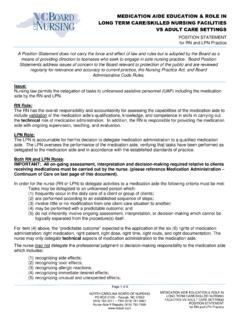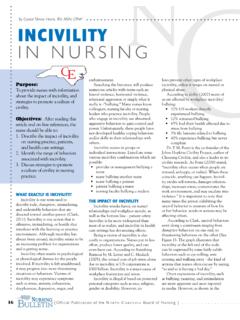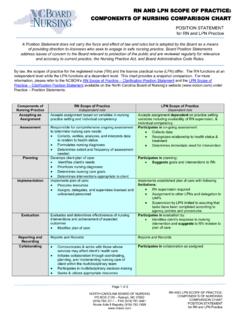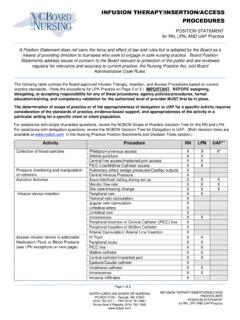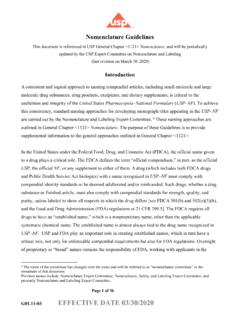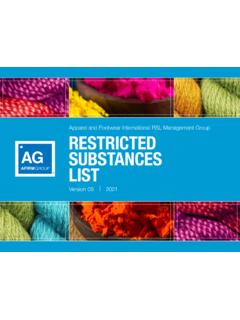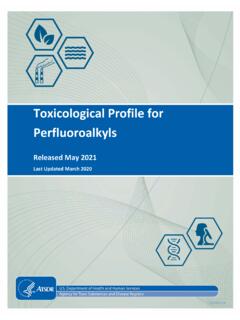Transcription of PROTECT YOUR NURSING LICENSE
1 6 ULLETINBULLETINBNURSINGNURSING {Official Publication of the NORTH CAROLINA Board of NURSING } ..INTRODUCTION The purpose of this article is to provide information for nurses regarding best practices for handling, document-ing, and administering controlled substances within a variety of healthcare settings while staying attuned to the signs of substance abuse and diversion. When best practices aren t followed, a violation of the NURSING Practice Act could result, cause patient harm, and contribute to the opioid epidemic or to the substance use disorder of a colleague; all of which may put the licensed nurse in a position of being investigated. The information provided in this article will improve your knowledge of state and federal regulations regarding controlled substances, lead to safer patient care provided by nurses, and may assist in the identification of abuse and diversion of controlled substances.
2 The North Carolina Board of NURSING s (NCBON) mission is to PROTECT the public by regulating the practice of NURSING (NCBON, 2018). As the occupational licensing board for nurses in North Carolina, the Board is acutely aware of the opioid epidemic and its impact on the NURSING profession. This article will present techniques nurses can use to maintain safe practice standards while working with controlled substances and in turn, increase patient ACCOUNTABILITY FOR CONTROLLED SUBSTANCES Nurses are in the most direct position in the healthcare continuum to PROTECT patients by ensuring there is adequate documentation in the medical record to support the administration and wasting of controlled substances. The types of storage for controlled substances include, but are not limited to, locked medication carts, locked cabinets, and automated dispensing systems ( , Pyxis or Omicell ), with the choice being based on a facility s size, available resources, and the volume of controlled substances dispensed (Lockwood, 2017).
3 The act of retrieving or removing a con-trolled substance from a secure, locked location places the nurse in possession of the drug and ultimately responsible to account for the entire amount removed. A nurse is charged with multiple areas of patient care responsibility related to medication administration including assessment, order verification, retrieval and preparation of the correct dose, administration, and documentation. Think back to your NURSING school days and the often-repeated statement: if it s not documented, it wasn t done. This continues to hold true throughout all aspects of NURSING practice and is essential for all record keeping related to controlled substances. Only through clear, timely, and accurate documentation of all elements of the administration and wasting of controlled substances can the nurse fulfill the responsibility of accounting for all of the substance removed from the secure storage site.
4 Regardless of what system is used by a facility, documentation requirements are the same but may occur in different formats ( , paper vs electronic). A basic requirement for documentation of a controlled substance ordered on an as needed (PRN) basis is to include the reason for the medication ( , pain, anxiety, sleep). If the medication is being given for pain, documentation should include the location of the pain, along with the appropriate pain scale rating, date, time, route, amount (based on provider order), and a follow-up if the medication was effective or not. The patient s description of pain should be PROTECT YOUR NURSING LICENSE Safe Handling, Administration, and Documentation of Controlled SubstancesSara A. Griffith MSN, RN7 ..included in the medical record if any additional descriptors are provided. When controlled substances are administered on a routine, regular, or scheduled basis, the documentation of ongoing assessments and evaluations of patient status and medication effectiveness are just as important.
5 Your agency policy and procedure will guide you on any agency specific requirements. Documentation processes may vary, depending on the facility; however, the required components of documentation of the administration or disposal of a controlled substance remain the same regardless of practice setting. For example, nurses working in long-term care facilities often use paper documentation. They are required to document the removal of the controlled substance on a controlled substance inventory form, document the time, date of the medication administra-tion on the medication administration record (MAR), and finally, document why the medication was given along with the effect of the medication in the appropriate area on the MAR. In facilities that utilize an electronic format for document-ing, the nurse may be required to scan the controlled substance medication prior to administration. The scanner documents the date and time of the administration; however, the nurse is required to document the assessment related to the pain scale used and follow-up documentation related to the effectiveness of the controlled substance .
6 This may include, for example, a follow-up within an hour for oral medications or a follow-up within 30 minutes for intravenous medications. The intervals for this follow-up evaluation may vary by agency policy and regulatory requirements. If the agency uses an electronic scanning system to document administration of medications, it is the nurse s responsibility to ensure the scanner is function-ing. If not functioning, report this immediately to your agency s information technology department or to NURSING leadership. This is an important action to ensure compliance with intu-itional polices and regulations relating to the safe use, storage, and disposal of scheduled CONTROLLED SUBSTANCES When controlled substances are retrieved or removed from secure storage in quantities in excess of that to be adminis-tered, the nurse is responsible for wasting or destroying the unneeded portion in the presence of a witness.
7 The best practice for wasting of controlled substances is to waste at the time of removal from the storage location. The witnessing nurse should visually watch the administering nurse as the correct dose is drawn up or as a pill cutter is used to obtain the ordered amount, observe as the unneeded portion is wasted in the agency-approved manner or receptacle, and then document the waste electronically or in writing. According to Brummond et al. (2017), the witness to the wasting of controlled substances should verify the following: product label, amount wasted matches what is documented, and that the medication is wasted in an irretrievable location. To strengthen an agency s policies and procedures on controlled substances, an agency should consider including the following statements: an unused controlled substance should be returned instead of wasted; administration should occur immediately after a controlled substance is removed from its storage location; and controlled substances should only be removed for one patient at a time (New, 2014).
8 These practices reduce the chance of forgetting to waste a controlled substance or taking a controlled substance outside the facility. Unused portions of controlled substances should not be carried by the nurse, left unattended on a counter, nor returned to the locked storage location. Both the administering nurse and the witness are responsible for documenting the wastage according to facility policy. A nurse should never document witnessing controlled substance wastage that was not actually OF CONTROLLED SUBSTANCES Controlled substances are subject to both Federal and State regulations. The United States Drug Enforcement Agency (DEA) has categorized drugs into categories, called schedules, based on the level of risk to the public, the drug s acceptable medical use, and the potential for abuse or dependency. Five schedules of drugs, including both prescribed controlled substances and illicit substances, are designated by the DEA.
9 Nurses should be familiar with each schedule and why these substances are scheduled by the DEA. The DEA can change the schedules based on new evidence regarding indications for the drug. For example, schedule I drugs are illegal substances due the fact that they have high risk for abuse leading to physical or psychological dependence and have no current medically accepted use. However, because the medical and recreational use of marijuana is expanding with the implemen-tation of various State laws, the current DEA schedule may be altered as increasing evidence of efficacy and/or risk emerges. The five schedules identified by the DEA are listed below with examples of common medications nurses may administer frequently in their NURSING practice (with the exception of schedule I which are illegal substances): Schedule I- heroin, marijuana, LSD, MDMA AKA ecstasy Schedule II- Morphine, Methadone, Oxycodone, Fentanyl, Hydromorphone, Hydrocodone, Dilaudid, Adderall, Ritalin, and OxyContin Schedule III- buprenorphine, Codeine with NSAID, marinol, and anabolic steroids Schedule IV- benzodiazepines (Xanax, Ativan), Ambien , Sonata , Tramadol, Soma8 ULLETINBULLETINBNURSINGNURSING {Official Publication of the NORTH CAROLINA Board of NURSING }.
10 Schedule V- Lyrica , Lomotil , cough suppressants with low dose codeine When a medication is scheduled by the DEA, this requires nurses to count and conduct inventories of each medica-tion. Some facilities may choose to also require counts for non-controlled sub-stances due to high risk of diversion or high cost of medication. Those medica-tions counted and inventoried are those subject to stringent documentation requirements for administration and wastage. In long-term care facilities, the practice of borrowing controlled substances dispensed for one resident for administration to another when the supply is not available places the nurse and the patient at risk. The risk of administering the wrong medication is increased due to the potential of con-fusing the various controlled substance names. The risk is also increased by bypassing the established safety process of a pharmacist verifying the medica-tion (dosage, patient name, allergies).
